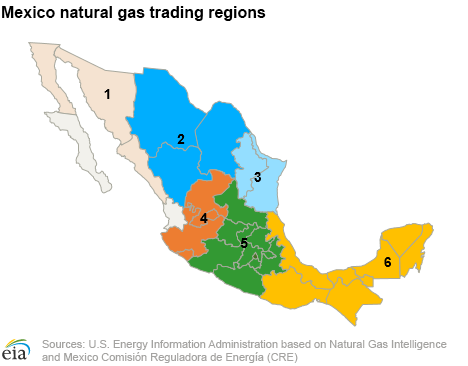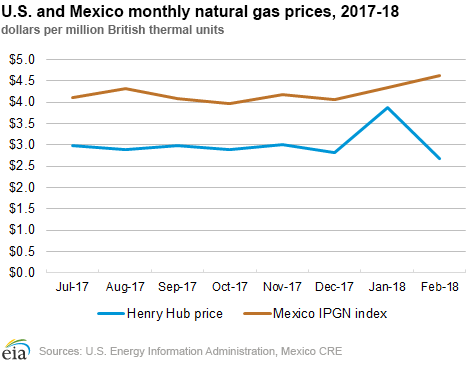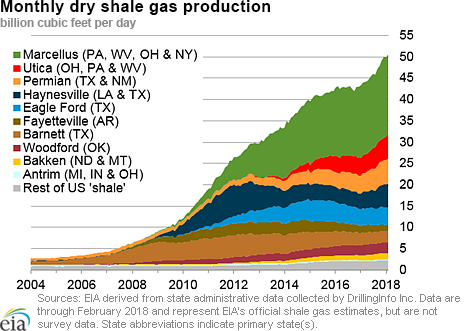In the News:
Mexico’s Energy Regulatory Commission publishes regional natural gas prices for the first time
As part of the ongoing liberalization of the Mexican natural gas market, on March 22, Mexico’s Energy Regulatory Commission (CRE) published for the first time monthly natural gas prices for six trading regions in the country. The regional prices supplement the national monthly natural gas price index, called IPGN, which was launched in August 2017.
CRE collects data for the pricing indexes based on monthly post-transactional reports that all natural gas marketers operating in Mexico are required to file. Monthly regional price indexes include the average prices paid for natural gas plus transportation costs for all transactions that took place in each region during the previous month.
The selection of regions was based on regional natural gas supply patterns, existing and in-development pipeline transportation infrastructure, prices and trading volumes reported by each state, and market shares of natural gas traders (assessed in the second half of 2017), according to CRE. Regional aggregations also considered tariff zones and flows on Sistrangas, which is the largest pipeline network in Mexico. These six regions encompass all but two (Nayarit and Baja California Sur) of the 31 Mexican states.
Average monthly regional prices for February 2018 ranged from $6.0582 per million British thermal units (MMBtu) (Region 1) to $4.2475/MMBtu (Region 3). Regions 3 and 5 reported the largest number of transactions (30 and 68, respectively) and traded volumes (45 Bcf and 55 Bcf, respectively) among the six regions, together accounting for 67% of all trades during February 2018. Region 3 includes the industrialized states of Nuevo Leon and Tamaulipas and is the main location of Mexico’s interconnections with U.S. border-crossing pipelines. About three quarters of U.S. natural gas pipeline exports to Mexico flow through this region. Nuevo Leon’s capital city, Monterrey, is likely to become the location of Mexico’s first natural gas trading hub, according to Natural Gas Intelligence. Region 5 is the location of Mexico’s most densely populated states and the largest natural gas consumption centers in the country, including Mexico City.
The six regional indexes are intended to provide general regional price information and will be replaced by spot prices from liquid trading hubs once they are developed. In addition to national and regional monthly indexes, CRE plans to publish daily forward-looking price indexes compiled from the daily trading reports. Similar to reporting monthly national index IPGN and six regional indexes, CRE will start reporting the daily regional indexes after the national daily index is launched.
Overview:
(For the Week Ending Wednesday, April 4, 2018)
- Natural gas spot prices rose at most locations this report week (Wednesday, March 28 to Wednesday, April 4). The Henry Hub spot price rose from $2.64 per million British thermal units (MMBtu) last Wednesday to $2.77/MMBtu yesterday.
- At the New York Mercantile Exchange (Nymex), the May 2018 contract price rose 2¢ from $2.698/MMBtu last Wednesday to $2.718/MMBtu yesterday.
- Net withdrawals from working gas totaled 29 billion cubic feet (Bcf) for the week ending March 30. Working natural gas stocks are 1,354 Bcf, which is 34% lower than the year-ago level and 20% lower than the five-year (2013–17) average for this week.
- The natural gas plant liquids composite price at Mont Belvieu, Texas, fell by 21¢, averaging $7.25/MMBtu for the week ending April 4. The price of natural gasoline, propane, butane, and isobutane fell by 5%, 3%, 6%, and 5%, respectively while the price of ethane rose by 4%.
- According to Baker Hughes, for the week ending Tuesday, March 27, the natural gas rig count increased by 4 to 194. The number of oil-directed rigs fell by 7 to 797. The total rig count fell by 2, and it now stands at 993.
Prices/Supply/Demand:
Prices rise steadily across the Lower 48 states. This report week (Wednesday, March 28 to Wednesday, April 4), the Henry Hub spot price rose 13¢ from $2.64/MMBtu last Wednesday to $2.77/MMBtu yesterday. Colder-than-normal temperatures from the Dakotas to the Northeast at the end of the report week put upward pressure on prices. Prices climbed steadily throughout the week, ending Wednesday with weekly highs at most pricing hubs.
At the Chicago Citygate, prices increased 54¢ from a low of $2.40/MMBtu last Wednesday to a high of $2.94/MMBtu yesterday. Prices at PG&E Citygate in Northern California rose 10¢, from $2.56/MMBtu last Wednesday to $2.66/MMBtu yesterday. The price at SoCal Citygate increased 55¢ from its low of $2.42/MMBtu last Wednesday to its high of $2.97/MMBtu yesterday amid a March 28 notice for a capacity reduction through SoCalGas’s Southern zone.
Northeast prices rise. At the Algonquin Citygate, which serves Boston-area consumers, prices went up $4.46 from a low of $2.35/MMBtu last Wednesday to $6.81/MMBtu yesterday after reaching a high of $7.23/MMBtu on Tuesday. In anticipation of cold weather through the weekend, on Wednesday, April 4, Algonquin Gas Transmission delayed a scheduled outage at the Stony Point and Oxford Compressor stations expected to start that day. The outages will now begin April 10.
At the Transcontinental Pipeline Zone 6 trading point for New York, prices increased 40¢ from a low of $2.52/MMBtu last Wednesday to a high of $2.92/MMBtu yesterday.
Tennessee Zone 4 Marcellus spot prices increased 37¢ from a low of $2.06/MMBtu last Wednesday to a high of $2.43/MMBtu yesterday. Prices at Dominion South in northwest Pennsylvania rose 48¢ from a low of $2.09/MMBtu last Wednesday to a high of $2.57/MMBtu yesterday.
Nymex prices show limited movement. At the Nymex, the price of the May 2018 contract increased 2¢, from $2.698/MMBtu last Wednesday to $2.718/MMBtu yesterday. The price of the 12-month strip averaging May 2018 through April 2019 futures contracts climbed 2¢ to $2.876/MMBtu.
Supply remains flat. According to data from PointLogic Energy, the average total supply of natural gas remained the same as in the previous report week, averaging 85.8 Bcf/d. Dry natural gas production increased by an average of 0.4 Bcf/d week over week. Average net imports from Canada decreased by 5% from last week.
Demand falls. Total U.S. consumption of natural gas fell by 6% compared with the previous report week, according to data from PointLogic Energy. Natural gas consumed for power generation declined by 2% week over week. Industrial sector consumption decreased by 1% week over week. In the residential and commercial sectors, consumption declined by 13%, as weather was warmer than normal in California and across the south and close to normal on the eastern seaboard. Natural gas exports to Mexico decreased 9% because of maintenance on the Los Ramones pipeline in Mexico. Mexico has pushed the in-service date for the El Encino-La Laguna pipeline back to October 2018, according to Genscape, which may affect export growth from the Permian basin.
U.S. liquefied natural gas (LNG) exports increase week over week. Six vessels (combined LNG-carrying capacity 21.4 Bcf) departed the Sabine Pass liquefaction facility from March 29 to April 4. One vessel (LNG-carrying capacity 3.8 Bcf) was loading at the terminal on Wednesday.
After loading the first commissioning cargo at Dominion Energy Cove Point liquefaction terminal on March 1, the tanker Gemmata returned to the facility on April 3 to load the second commissioning cargo. Two other vessels are currently en route to Cove Point—Patris, controlled by Tokyo Gas and scheduled to arrive on April 9, and LNG Sakura, controlled by Kansai Electric and scheduled to arrive on April 20.
Storage:
While working gas net withdrawals are somewhat higher than the five-year average, net flows from storage were lower than the five-year average. Net withdrawals from storage totaled 29 Bcf for the week ending March 30, compared with the five-year (2013–17) average net withdrawals of 28 Bcf and last year's net withdrawals of 4 Bcf during the same week. The implied net flow for the week, which excludes the effects of a 9 Bcf non-flow-related adjuistment in the South Central nonsalt region, totaled 20 Bcf. Working gas stocks totaled 1,354 Bcf, which is 347 Bcf lower than the five-year average and 697 Bcf lower than last year at this time.
Non-flow-related adjustments lower working gas levels in the South Central Nonsalt region. These types of adjustments are commonly the result of an engineering assessment of the working gas inventories that reduces the level of working gas in the field but does not reclassify them as base gas. Base gas levels were not affected by this week’s non-flow-related adjustment. Periodic pressure testing of the storage facility allows engineers to determine inventory losses that may have occurred as a result of cycling natural gas in and out of a natural gas storage facility over time.
The average May 2018 futures contract price trades at a premium to the average weekly spot price. During the most recent storage week, the average natural gas spot price at the Henry Hub was $2.63/MMBtu, 4¢/MMBtu lower than the front-month futures price at the Nymex. A year ago, the spot price was 14¢ lower than the front-month contract.
Reported net flows of 20 Bcf out of storage are lower than most analysts’ expectations. According to the Desk survey of natural gas analysts, estimates of the weekly net change in working natural gas storage ranged from 21 Bcf to 41 Bcf, with a median of 26 Bcf. Prices for the futures contract for May delivery at the Henry Hub fell 3¢/MMBtu to $2.66/MMBtu in 2,394 trades following the release of the Weekly Natural Gas Storage Report. Prices rebounded somewhat in subsequent trading, averaging $2.68/MMBtu.
Temperatures are relatively normal across the Lower 48 states during the storage week. Temperatures in the Lower 48 states averaged 46 degrees Fahrenheit (°F), 2°F lower than the normal and 6°F lower than last year at this time. The average temperature was slightly higher than during the prior storage week.
See also:
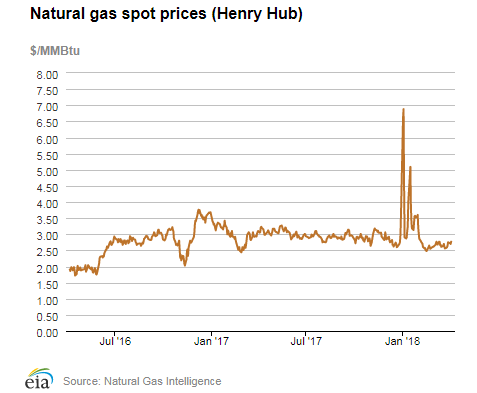
| Spot Prices ($/MMBtu) | Thu, 29-Mar |
Fri, 30-Mar |
Mon, 02-Apr |
Tue, 03-Apr |
Wed, 04-Apr |
|---|---|---|---|---|---|
| Henry Hub | 2.75 | Closed | 2.72 | 2.70 | 2.77 |
| New York | 2.77 | Closed | 2.75 | 2.81 | 2.92 |
| Chicago | 2.66 | Closed | 2.65 | 2.72 | 2.94 |
| Cal. Comp. Avg.* | 2.96 | Closed | 2.91 | 2.75 | 2.70 |
| Futures ($/MMBtu) | |||||
| May Contract | 2.733 | Closed | 2.683 | 2.697 | 2.718 |
| June Contract | 2.778 | Closed | 2.732 | 2.745 | 2.766 |
| *Avg. of NGI's reported prices for: Malin, PG&E Citygate, and Southern California Border Avg. | |||||
| Source: NGI's Daily Gas Price Index | |||||
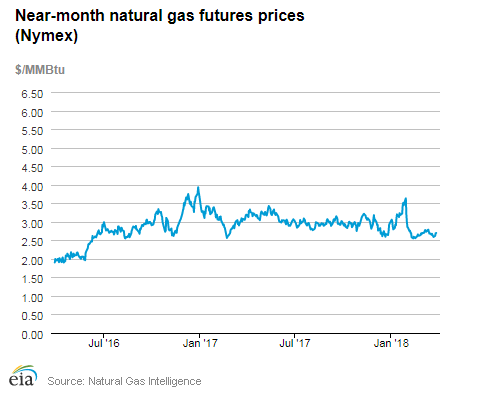
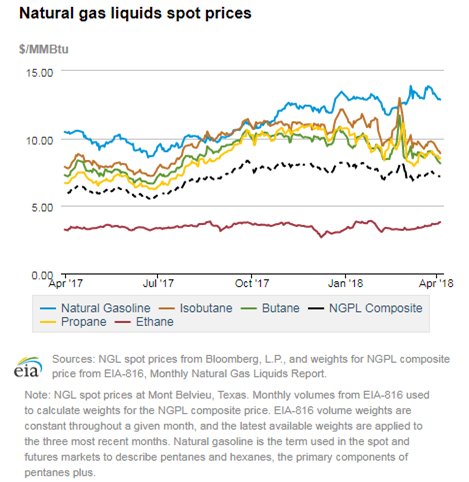
| U.S. natural gas supply - Gas Week: (3/29/18 - 4/4/18) | |||
|---|---|---|---|
Average daily values (Bcf/d): |
|||
this week |
last week |
last year |
|
| Marketed production | 89.8 |
89.4 |
79.8 |
| Dry production | 79.6 |
79.2 |
71.2 |
| Net Canada imports | 6.1 |
6.4 |
5.7 |
| LNG pipeline deliveries | 0.1 |
0.3 |
0.1 |
| Total supply | 85.8 |
85.9 |
77.0 |
|
Source: OPIS PointLogic Energy, an IHS Company | |||
| U.S. natural gas consumption - Gas Week: (3/29/18 - 4/4/18) | |||
|---|---|---|---|
Average daily values (Bcf/d): |
|||
this week |
last week |
last year |
|
| U.S. consumption | 69.6 |
73.8 |
63.2 |
| Power | 22.8 |
23.2 |
22.4 |
| Industrial | 21.5 |
21.6 |
20.6 |
| Residential/commercial | 25.3 |
29.0 |
20.2 |
| Mexico exports | 4.0 |
4.4 |
4.0 |
| Pipeline fuel use/losses | 6.7 |
6.5 |
6.0 |
| LNG pipeline receipts | 3.6 |
3.3 |
1.9 |
| Total demand | 83.9 |
87.9 |
75.1 |
|
Source: OPIS PointLogic Energy, an IHS Company | |||
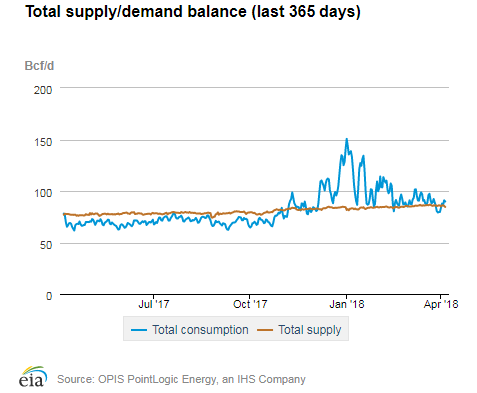
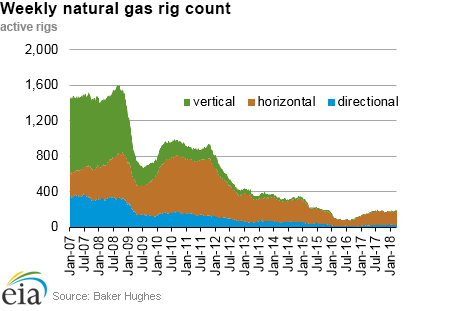
| Rigs | |||
|---|---|---|---|
Tue, March 27, 2018 |
Change from |
||
last week |
last year |
||
| Oil rigs | 797 |
-0.9% |
20.4% |
| Natural gas rigs | 194 |
2.1% |
21.3% |
| Note: Excludes any miscellaneous rigs | |||
| Rig numbers by type | |||
|---|---|---|---|
Tue, March 27, 2018 |
Change from |
||
last week |
last year |
||
| Vertical | 63 |
0.0% |
-8.7% |
| Horizontal | 870 |
0.0% |
27.0% |
| Directional | 60 |
-3.2% |
-14.3% |
| Source: Baker Hughes Inc. | |||
| Working gas in underground storage | ||||
|---|---|---|---|---|
Stocks billion cubic feet (Bcf) |
||||
| Region | 2018-03-30 |
2018-03-23 |
change |
|
| East | 229 |
242 |
-13 |
|
| Midwest | 266 |
284 |
-18 |
|
| Mountain | 87 |
88 |
-1 |
|
| Pacific | 166 |
166 |
0 |
|
| South Central | 606 C |
603 |
3 |
|
| Total | 1,354 C |
1,383 |
-29 |
|
|
| ||||
| Source: U.S. Energy Information Administration | ||||
| Working gas in underground storage | |||||
|---|---|---|---|---|---|
Historical comparisons |
|||||
Year ago (3/30/17) |
5-year average (2013-2017) |
||||
| Region | Stocks (Bcf) |
% change |
Stocks (Bcf) |
% change |
|
| East | 269 |
-14.9 |
284 |
-19.4 |
|
| Midwest | 480 |
-44.6 |
356 |
-25.3 |
|
| Mountain | 142 |
-38.7 |
122 |
-28.7 |
|
| Pacific | 215 |
-22.8 |
220 |
-24.5 |
|
| South Central | 944 |
-35.8 |
718 |
-15.6 |
|
| Total | 2,051 |
-34.0 |
1,701 |
-20.4 |
|
| Source: U.S. Energy Information Administration | |||||
| Temperature – heating & cooling degree days (week ending Mar 29) | ||||||||
|---|---|---|---|---|---|---|---|---|
HDD deviation from: |
CDD deviation from: |
|||||||
| Region | HDD Current |
normal |
last year |
CDD Current |
normal |
last year |
||
| New England | 185 |
6 |
-21 |
0 |
0 |
0 |
||
| Middle Atlantic | 183 |
21 |
30 |
0 |
0 |
0 |
||
| E N Central | 171 |
1 |
49 |
0 |
0 |
0 |
||
| W N Central | 177 |
11 |
50 |
0 |
-1 |
0 |
||
| South Atlantic | 114 |
24 |
60 |
11 |
-1 |
-6 |
||
| E S Central | 85 |
0 |
56 |
0 |
-5 |
-12 |
||
| W S Central | 33 |
-15 |
20 |
20 |
7 |
-15 |
||
| Mountain | 157 |
15 |
38 |
0 |
-4 |
-1 |
||
| Pacific | 105 |
23 |
24 |
0 |
-1 |
0 |
||
| United States | 138 |
10 |
37 |
4 |
-1 |
-4 |
||
|
Note: HDD = heating degree day; CDD = cooling degree day Source: National Oceanic and Atmospheric Administration | ||||||||
Average temperature (°F)
7-Day Mean ending Mar 29, 2018
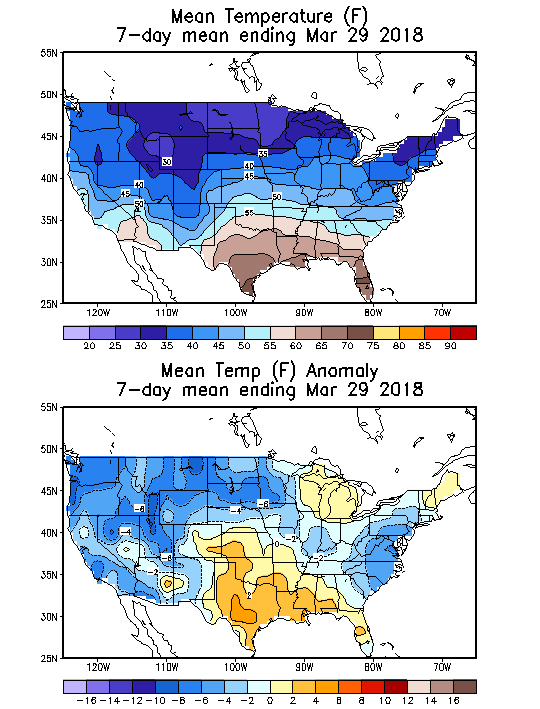
Source: NOAA National Weather Service
Deviation between average and normal (°F)
7-Day Mean ending Mar 29, 2018

Source: NOAA National Weather Service

